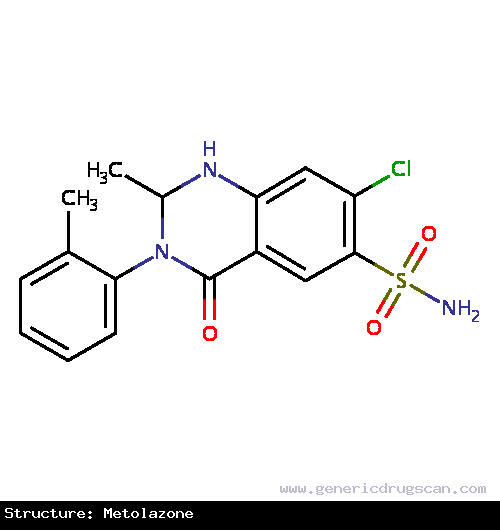Metolazone Drug: Indication, Dosage, Precaution, Side Effect , Storage, Category Type and corresponding Brands - www.genericdrugscan.com
Metolazone
Drug Status in USA : ApprovedDrug Status in Canada : Approved
pronunciation
pronounced as (me tol' a zone)
Why is this medication prescribed?
Metolazone, is used to reduce the swelling and fluid retention caused by heart failure or kidney disease. It also is used alone or with other medications to treat high blood pressure. Metolazone is in a class of medications called diuretics ('water pills'). It causes the kidneys to reduce the amount of water and salt in the body by increasing the amount of urine.
How should this medicine be used?
Metolazone comes as a tablet to take by mouth. It is usually taken once a day. Take metolazone at around the same time every day. Follow the directions on your prescription label carefully, and ask your doctor or pharmacist to explain any part you do not understand. Take metolazone exactly as directed. Do not take more or less of it or take it more often than prescribed by your doctor.
Your doctor will probably start you on a low dose of metolazone and gradually increase your dose, depending on your response to this medication.
Metolazone controls high blood pressure but does not cure it. Continue to take metolazone even if you feel well. Do not stop taking metolazone without talking to your doctor.
What are the precautions to be followed?
Before taking metolazone,- tell your doctor and pharmacist if you are allergic to metolazone, sulfa drugs, thiazides, any other medications, or any of the ingredients in metolazone tablets. Ask your pharmacist for a list of the ingredients.
- tell your doctor and pharmacist what other prescription and nonprescription medications, vitamins, nutritional supplements, and herbal products you are taking or plan to take. Be sure to mention any of the following: anticoagulants ('blood thinners') such as warfarin (Coumadin); aspirin and other nonsteroidal anti-inflammatory medications (NSAIDs) such as ibuprofen (Advil, Motrin) and naproxen (Aleve, Naprosyn); corticotropin; digoxin (Lanoxin); furosemide (Lasix); insulin or other medications for diabetes; lithium (Eskalith, Lithobid); medications for asthma and colds; medications for pain or seizures; methenamine (Hiprex, Urex); other medications for high blood pressure; sedatives; oral steroids such as dexamethasone (Decadron, Dexone), methylprednisolone (Medrol), and prednisone (Deltasone); tranquilizers; and vitamin D. Your doctor may need to change the doses of your medications or monitor you carefully for side effects.
- tell your doctor if you have kidney or liver failure. Your doctor will probably tell you not to take metolazone.
- tell your doctor if you have or have ever had diabetes, gout, systemic lupus erythematosus (SLE, a chronic inflammatory condition), or parathyroid, heart, kidney, or liver disease.
- tell your doctor if you are pregnant, plan to become pregnant, or are breast-feeding. If you become pregnant while taking metolazone, call your doctor.
- if you are having surgery, including dental surgery, tell the doctor or dentist that you are taking metolazone.
- you should know that metolazone may make you dizzy or drowsy. Do not drive a car or operate machinery until you know how this medication affects you.
- ask your doctor about the safe use of alcoholic beverages while you are taking metolazone. Alcohol can make the side effects from metolazone worse.
- plan to avoid unnecessary or prolonged exposure to sunlight and to wear protective clothing, sunglasses, and sunscreen. Metolazone may make your skin sensitive to sunlight.
- you should know that metolazone may cause dizziness, lightheadedness, and fainting when you get up too quickly from a lying position. This is more common when you first start taking metolazone. To avoid this problem, get out of bed slowly, resting your feet on the floor for a few minutes before standing up.
What are possible side effects of this medication ?
Metolazone may cause side effects. Tell your doctor if any of these symptoms are severe or do not go away:- dizziness
- weakness
- restlessness
- headache
- muscle cramps
- joint pain or swelling
- constipation
- diarrhea
- dry mouth, dark urine, decreased sweating, dry skin, and other signs of dehydration
- chest pain
- rapid, irregular, or pounding heartbeats
- hives
- rash
- itching
- blistering or peeling skin
- swelling of the face, throat, tongue, lips, eyes, hands, feet, ankles, or lower legs
- hoarseness
- difficulty swallowing or breathing
- sore throat with fever
- unusual bleeding or bruising
- upset stomach
- extreme tiredness
- loss of appetite
- pain in the upper right part of the stomach
- yellowing of the skin or eyes
- flu-like symptoms
Metolazone may cause other side effects. Call your doctor if you have any unusual problems while taking this medication.
How to store the medication and dispose it of after its use later?
Keep this medication in the container it came in, tightly closed, and out of reach of children. Store it at room temperature and away from light, excess heat and moisture (not in the bathroom). Throw away any medication that is outdated or no longer needed. Talk to your pharmacist about the proper disposal of your medication.
Drug Category/Class
- Low-Ceiling Diuretics and Potassium-Sparing Agents
- Sodium Chloride Symporter Inhibitors
- Low-Ceiling Diuretics, Excl. Thiazides
- Antihypertensive Agents
- Diuretics
- Sulfonamides, Plain
- Cardiovascular System
- Sulfonamides, plain
- Low-ceiling diuretics and potassium-sparing agents
| Prescribed | For the treatment of hypertension, alone or in combination with other antihypertensive drugs of a different class. |
| Weight : | 365.835 |
| Structure | Metolazone |
 | |
| Formula | C16H16ClN3O3S |
Metolazone has 19 Brands listed
Search Generic Drugs alphabetically
